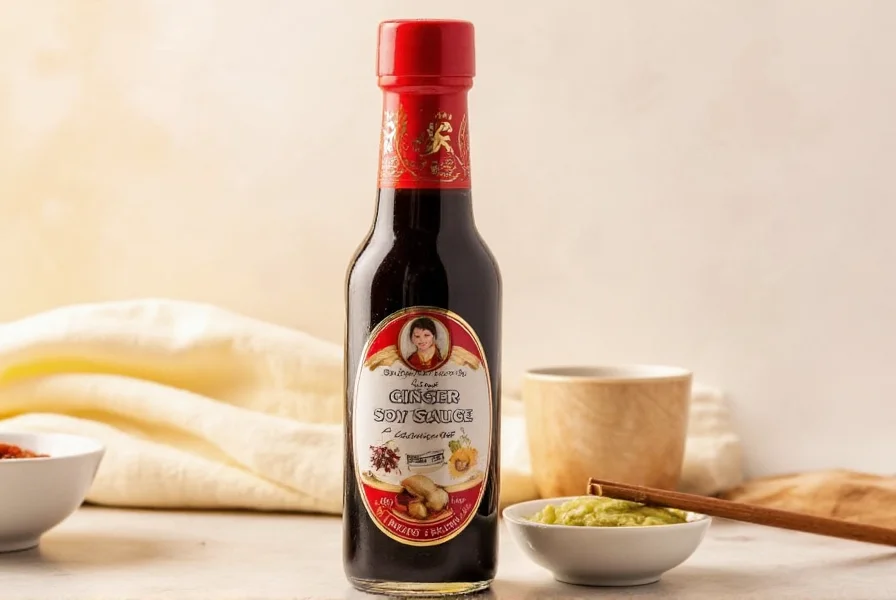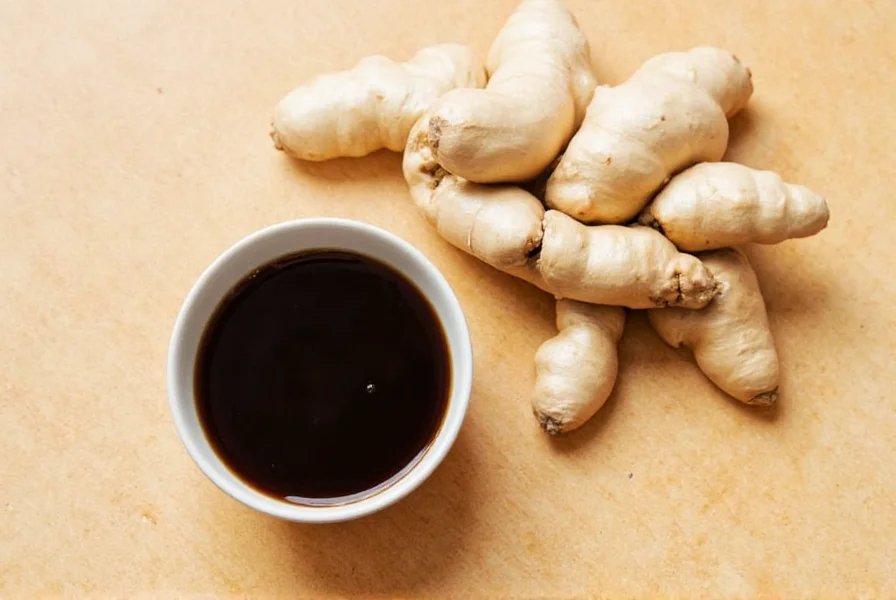Ginger soy sauce elevates everyday dishes with its complex flavor profile that balances saltiness, umami, and subtle heat. This popular Asian condiment has become a staple in both traditional and fusion cuisines worldwide, appreciated for its ability to enhance proteins, vegetables, and grains with minimal effort.
What Exactly Is Ginger Soy Sauce?
Ginger soy sauce represents a thoughtful fusion of two fundamental Asian ingredients: premium soy sauce and fresh ginger root. While standard soy sauce undergoes fermentation of soybeans, wheat, salt, and water, ginger soy sauce incorporates additional ginger elements during or after this process. Commercial varieties typically blend brewed soy sauce with ginger extract, grated ginger, or ginger flavoring, while artisanal versions often steep fresh ginger in high-quality soy sauce for days to develop nuanced flavors.
The ginger component introduces zesty, slightly spicy notes that complement rather than overpower the soy sauce's inherent umami. This creates a multidimensional condiment that works beautifully as both a finishing sauce and cooking ingredient. Unlike sweetened "ginger sauce" varieties, authentic ginger soy sauce maintains the savory foundation of traditional soy sauce while adding aromatic complexity.
Key Differences From Regular Soy Sauce
Understanding the distinction between ginger soy sauce and regular soy sauce helps home cooks make informed choices. While both share the same soy-based foundation, critical differences affect their culinary applications:
| Characteristic | Ginger Soy Sauce | Regular Soy Sauce |
|---|---|---|
| Primary Flavor Profile | Umami with distinct ginger notes | Pure umami and saltiness |
| Ingredients | Soy sauce plus ginger (fresh, extract, or powder) | Soybeans, wheat, salt, water |
| Best Culinary Uses | Marinades, dipping sauces, stir-fry finishing | General seasoning, base for sauces |
| Flavor Complexity | Layered with aromatic ginger notes | Straightforward umami profile |
These differences make ginger soy sauce particularly valuable when you want to add both saltiness and aromatic complexity simultaneously. The ginger element provides brightness that cuts through rich dishes, making it especially effective with fatty proteins like pork belly or duck.
Optimal Culinary Applications
Chefs and home cooks leverage ginger soy sauce in specific ways that maximize its unique properties. Understanding these applications transforms how you approach Asian-inspired cooking:
As a finishing sauce: Drizzle high-quality ginger soy sauce over steamed fish, grilled meats, or roasted vegetables just before serving. The raw ginger notes remain vibrant when not subjected to high heat, providing aromatic complexity that cooked applications might diminish.
In marinades: Combine with honey, garlic, and sesame oil for proteins. The ginger's natural enzymes help tenderize meats while the soy sauce penetrates for deep flavoring. For best results, marinate proteins for 30 minutes to 2 hours—extended marinating can make delicate proteins like fish too soft.
As a dipping sauce component: Mix with rice vinegar, a touch of honey, and chili flakes for an instant dipping sauce that complements dumplings, spring rolls, or tempura. The ginger element cuts through fried foods' richness while enhancing their flavor.
In stir-fries: Add during the final minute of cooking to preserve the ginger's bright notes. Unlike regular soy sauce which can withstand longer cooking, ginger soy sauce benefits from minimal heat exposure to maintain its distinctive character.

Creating Authentic Ginger Soy Sauce at Home
Commercial ginger soy sauce often contains additives and excessive sugar. Crafting your own ensures purity and lets you control the ginger intensity. This simple method produces restaurant-quality results:
Basic Homemade Ginger Soy Sauce Recipe
Yields approximately 1 cup | Preparation: 5 minutes | Infusion: 3-7 days
Ingredients:
- 1 cup high-quality tamari or naturally brewed soy sauce
- 2 tablespoons freshly grated ginger (fine julienne)
- 1 star anise (optional, for complexity)
- 1 teaspoon rice vinegar (optional, for brightness)
Instructions:
- Combine all ingredients in a clean glass jar with a tight-fitting lid
- Seal and shake gently to combine
- Store at room temperature away from direct sunlight for 3-7 days (longer = stronger ginger flavor)
- Strain through a fine-mesh sieve, pressing gently on solids to extract maximum flavor
- Transfer to a clean bottle and refrigerate (keeps for 3 months)
This method preserves the ginger's volatile aromatic compounds better than boiling, resulting in a more nuanced flavor. For immediate use, skip the infusion step and simply mix grated ginger directly into regular soy sauce, though the flavor won't be as integrated.
Effective Substitutes When Ginger Soy Sauce Isn't Available
Rather than searching for the best ginger soy sauce brands, sometimes creating an equivalent from pantry staples proves more practical. Consider these substitution approaches based on your specific need:
- For marinades: Combine regular soy sauce with freshly grated ginger (1 tablespoon per ¼ cup soy sauce) plus a pinch of white pepper
- For dipping sauces: Mix soy sauce with grated ginger, rice vinegar, and a touch of honey for balance
- For stir-fries: Use regular soy sauce plus minced ginger added during the final cooking stage
- For delicate dishes: Dilute regular soy sauce with a ginger tea (steep fresh ginger in hot water for 10 minutes) to achieve similar flavor intensity without overpowering
Avoid using pre-made "ginger sauce" products as substitutes, as these typically contain significant sugar and other ingredients that alter the intended flavor profile. Understanding ginger soy sauce nutritional information becomes important when substituting, as commercial versions often include added sugars.
Nutritional Profile and Storage Considerations
Ginger soy sauce maintains similar nutritional properties to regular soy sauce with minor variations depending on preparation. A typical tablespoon (15ml) contains:
- Calories: 10-15
- Sodium: 900-1,000mg (40% of daily value)
- Carbohydrates: 1-2g
- Protein: 1g
- Ginger compounds: Varies by preparation method
The ginger component adds beneficial compounds like gingerols without significantly altering the nutritional profile. When evaluating ginger soy sauce nutritional information, note that commercial varieties sometimes include added sugar or preservatives that affect the nutritional content.
Proper storage preserves flavor and quality. Keep opened bottles refrigerated to maintain freshness, as the ginger components can degrade more quickly than standard soy sauce. Most commercial varieties remain optimal for 6-12 months after opening when refrigerated, while homemade versions typically last 2-3 months due to the absence of preservatives.

Maximizing Flavor in Your Cooking
Professional chefs employ specific techniques to maximize ginger soy sauce's potential in dishes. Understanding how to use ginger soy sauce in cooking separates adequate results from exceptional ones:
For proteins, apply ginger soy sauce in stages—use some in the marinade for penetration and reserve some for finishing to provide aromatic complexity. With vegetables, particularly hearty varieties like bok choy or broccoli, toss with ginger soy sauce during the final minute of cooking to preserve the ginger's bright notes.
When making sauces or glazes, combine ginger soy sauce with complementary elements like citrus zest, garlic, or a touch of sweetness from honey or mirin. The ginger's natural pungency balances rich ingredients, making it particularly effective in dishes featuring fatty cuts of meat or creamy elements.
What's the difference between ginger soy sauce and regular soy sauce?
Ginger soy sauce contains added ginger elements that provide distinctive aromatic and slightly spicy notes while maintaining the umami foundation of regular soy sauce. Regular soy sauce offers pure umami and saltiness without the additional ginger complexity. This makes ginger soy sauce particularly effective for dishes needing both saltiness and aromatic brightness.
Can I substitute regular soy sauce for ginger soy sauce in recipes?
Yes, but you'll need to add fresh ginger to compensate. For every ¼ cup of ginger soy sauce required, use regular soy sauce plus 1 tablespoon freshly grated ginger. Add the ginger early for marinades but near the end of cooking for stir-fries to preserve its bright flavor notes.
Does ginger soy sauce contain more sodium than regular soy sauce?
Generally, no. Most ginger soy sauce varieties maintain similar sodium levels to their regular counterparts, typically around 900-1,000mg per tablespoon. Always check labels as some commercial versions may add salt during processing, while others might dilute sodium content slightly with added ingredients.
How long does homemade ginger soy sauce last?
Properly stored in a sealed container in the refrigerator, homemade ginger soy sauce maintains optimal flavor for 2-3 months. The absence of preservatives means it won't last as long as commercial varieties, which typically remain fresh for 6-12 months after opening when refrigerated. Discard if you notice any mold, off smells, or significant color changes.
What dishes work best with ginger soy sauce?
Ginger soy sauce excels with grilled or roasted proteins (especially salmon, chicken, and pork), steamed vegetables, and as a finishing touch for noodle dishes. Its bright notes cut through rich foods, making it ideal for fatty cuts of meat. It also works beautifully as a dipping sauce component for dumplings and spring rolls when mixed with rice vinegar and a touch of honey.











 浙公网安备
33010002000092号
浙公网安备
33010002000092号 浙B2-20120091-4
浙B2-20120091-4